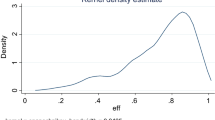Abstract
Since 2000, Japanese enterprises have begun commonly holding a large amount of cash while reducing interest-bearing debt. A-share listed companies in China from 2009 to 2018 are examined in this study to find a similar phenomenon among Chinese enterprises, which can be quantified as “financial excess”. The relationship among financial excess and labor-capital financial distribution and innovation output in Chinese listed companies is investigated accordingly. There appears to be a significant “inverted U-shaped” relationship between financial excess and the labor-capital financial distribution. The moderating effect of innovation activities gives financial excess a stronger influence on the fairness of the labor-capital financial distribution, making the curve shape steeper. Financial excess and fair financial distribution indicators are combined in this work for the first time, which marks a significant contribution to the literature. This work also may have practical significance for enterprises seeking to improve their fund utilization efficiency and to ensure sustainable development.
Access this chapter
Tax calculation will be finalised at checkout
Purchases are for personal use only
Similar content being viewed by others
References
Acemoglu, D., Linn, J.: Market size in innovation: theory and evidence from the pharmaceutical industry. Q. J. Econ. 119(3), 1049–1090 (2004)
Barton, L.S., Hill, C.N., Sundaram, S.: An empirical test of stakeholder theory predictions of capital structure. Financ. Manag. 36–44 (1989)
Bates, T.W., Kahle, K.M., Stulz, R.M.: Why do us firms hold so much more cash than they used to? J. Financ. 64(5), 1985–2021 (2009)
Berkovitch, E., Israel, R., Spiegel, Y.: Managerial compensation and capital structure. J. Econ. Manag. Strategy 9(4), 549–584 (2000)
Berzkalne, I., Zelgalve, E.: Capital structure and innovation: a study of baltic listed companies. Changes Soc. Bus. Environ. (5), 13–21 (2013)
Billings, B.A., Fried, Y.: The effects of taxes and organizational variables on research and development intensity. R&D Manag. 29(3), 289–302 (1999)
Bromiley, P.: Testing a causal model of corporate risk taking and performance. Acad. Manag. J. 34(1), 37–59 (1991)
Can, W., Shengdao, G., Weizhang, S.: A study on measuring financial justice in the perspective of employee compensation: evidence from listed companies based in Sichuan. J. Nan**g Audit Univ. (5), 105–113 (2012). (in Chinese)
Casson, P.D., Martin, R., Nisar, T.M.: The financing decisions of innovative firms. Res. Int. Bus. Financ. 22(2), 208–221 (2008)
Chemmanur, T.J., Cheng, Y., Zhang, T.: Human capital, capital structure, and employee pay: an empirical analysis. J. Financ. Econ. 110(2), 478–502 (2013)
Dittmar, A., Mahrt-Smith, J., Servaes, H.: International corporate governance and corporate cash holdings. J. Financ. Quant. Anal. 111–133 (2003)
GanShengdao, C.R., Dan, X.H.: Financial excess: concept creation and research topic. Friends Account. (1), 10–13 (2020). (in Chinese)
Harford, J., Li, K., Zhao, X.: Corporate boards and the leverage and debt maturity choices. Int. J. Corp. Gov. 1(1), 3–27 (2008)
Jensen, M.C.: Agency costs of free cash flow, corporate finance, and takeovers. Am. Econ. Rev. 76(2), 323–329 (1986)
Jensen, M.C., Meckling, W.H.: Theory of the firm: managerial behavior, agency costs and ownership structure. J. Financ. Econ. 3(4), 305–360 (1976)
Klasa, S., Maxwell, W.F., Ortiz-Molina, H.: The strategic use of corporate cash holdings in collective bargaining with labor unions. J. Financ. Econ. 92(3), 421–442 (2009)
Laeven, L., Valencia, F.: The use of blanket guarantees in banking crises. J. Int. Money Financ. 31(5), 1220–1248 (2012)
Lin, H.-C., Chou, T.-K., Wang, W.G.: Capital structure and executive compensation contract design: a theoretical and empirical analysis. J. Bank. Finan. 36(1), 209–224 (2012)
Müller, E., Zimmermann, V.: The importance of equity finance for R&D activity. Small Bus. Econ. 33, 303–318 (2009)
Myers, S.C., Majluf, N.S.: Corporate financing and investment decisions when firms have information that investors do not have. Technical report 13, National Bureau of Economic Research (1984)
Pinkowitz, L., Stulz, R., Williamson, R.: Does the contribution of corporate cash holdings and dividends to firm value depend on governance? A cross-country analysis. J. Financ. 61(6), 2725–2751 (2006)
Richardson, S.: Over-investment of free cash flow. Rev. Acc. Stud. 11(2–3), 159–189 (2006)
Schroth, E., Szalay, D.: Cash breeds success: the role of financing constraints in patent races. Rev. Finan. 14(1), 73–118 (2010)
Shengdao, G., Wenbing, W., Min, Q.: Research on financial slack and excess employee responsibility in central enterprises. J. Nan**g Audit Univ. (4), 55–61 (2012). (in Chinese)
Wang, J., Wu, Y., Wu, S.: Research on the zero debt behavior of listed companies in China: financing constraint or financial elasticity? Manag. Revi. 28(6), 32–41 (2016). (in Chinese)
Acknowledgements
I would like to express my sincere and deep gratitude to my supervisor, Professor Gan Shengdao, for his inspiration, valuable instructions, and patience. He offered me a great deal of advice, particularly in determining the topic and revising the paper. I am also greatly indebted to the professors who have instructed me throughout my thesis-writing process. Thank you.
Author information
Authors and Affiliations
Editor information
Editors and Affiliations
Rights and permissions
Copyright information
© 2021 The Author(s), under exclusive license to Springer Nature Switzerland AG
About this paper
Cite this paper
Gan, S., Qin, M. (2021). Effects of Financial Excess on the Fairness of Labor - Capital Financial Distribution: Evidence from China. In: Xu, J., García Márquez, F.P., Ali Hassan, M.H., Duca, G., Hajiyev, A., Altiparmak, F. (eds) Proceedings of the Fifteenth International Conference on Management Science and Engineering Management. ICMSEM 2021. Lecture Notes on Data Engineering and Communications Technologies, vol 79. Springer, Cham. https://doi.org/10.1007/978-3-030-79206-0_2
Download citation
DOI: https://doi.org/10.1007/978-3-030-79206-0_2
Published:
Publisher Name: Springer, Cham
Print ISBN: 978-3-030-79205-3
Online ISBN: 978-3-030-79206-0
eBook Packages: Intelligent Technologies and RoboticsIntelligent Technologies and Robotics (R0)




